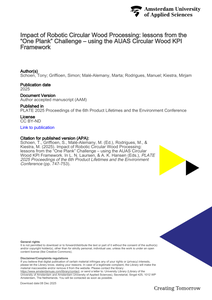Wood is an increasingly demanded renewable resource and an important raw material for construction and materials. Demands are rising, with a growing attention for re-use and upcycling. This opens opportunities for new business models, empowered by the use of digital design and technologies. A KPI-framework has thus been developed to assess the impact of waste wood upcycling, to provide new business perspectives. It is conceived as a tool to enable circular businesses to select the most appropriate circular wood applications for their portfolio. The framework currently consists of eight indicators addressing circularity, environment, society and economics. This paper presents these indicators and shares insights for further development and enhancement of the framework.
MULTIFILE

In our in-depth case study on two circular business models we found important roles for material scouts and networks. These key partners are essential for establishing circular business models and circular flow of materials. Besides, we diagnose that companies are having difficulties to develop viable value propositions and circular strategies. The paper was presented at NBM Nijmegen 2020 and will be published at a later date
DOCUMENT

The video was a compilation of the RAAK-publiek research project 'Circular Wood for the Neighborhood', carried out by the Digital Production Research Group with partners in 2020-2022.
DOCUMENT
The Circular Wood 4.0 Workflow API is a comprehensive and automated “file-to-factory” system that bridges the gap between design using waste wood resources and production processes aligned with Smart Industry principles. This software serves as the core IT infrastructure for an end-to-end automated workflow, enabling seamless data flow from material availability to final production. Key features include full traceability, real-time process monitoring, and integration of design and manufacturing stages. The API is composed of several interconnected components that manage the entire workflow, from intelligent resource matching and design generation to production preparation and execution; facilitating efficient, sustainable, and transparent fabrication processes.
LINK
Students of the Minor Robotic Production & Circular Materials, collectively built a 6-meter Christmas tree from residual wood donated by Amsterdamse Fijnhout
DOCUMENT
The exhibition presented the outcomes of the project 'Circular Wood for the Neighborhood', which was carried out by the Digital Production Research Group in 2020-2022. The exhibition consisted of ten panels with mixed media, objects and video's. The exhibition was displayed at the offices of the project partners Rochdale and Ymere, at the Municipality of Amsterdam and at the Jacoba Mulderhuis, home of AUAS Faculty of Technology
LINK
Wood is an increasingly demanded renewable resource and an important raw material for construction and materials. Demands are rising, with a growing attention for re-use and upcycling, opening up opportunities for new business models, empowered by the use of digital design and technologies. A KPI framework was developed to evaluate the environmental, social, and economic aspects of using recycled wood in robotic manufacturing. This paper explores the use of this framework, focusing on a case study: the "One Plank" Challenge. The study reveals that environmental gains from using waste wood are comparable to production burdens, with significant variation depending on wood type. Production time, encompassing both human and robotic aspects, significantly impacts cost-effectiveness. The findings underscore the importance of considering lifecycle impacts in promoting sustainable robotic manufacturing practices.
MULTIFILE

Results of the CW.Code Research Project
DOCUMENT

Collaborating with industry partners, the study investigates the use of digital design and robotic technology to optimize the utilization of residual wood. By employing computational design, custom products can be generated from mixed wood batches, enabling circular applications previously unattainable through manual methods. Notably, a reception desk was produced for the Johan Cruyff Arena using over 300 parts of residual hardwood, highlighting market potential for interiors from used wood in hospitality, a sector striving to become more sustainable. The research focuses on developing a smart ‘upcycle wood factory’ powered by Industry 4.0 technologies, integrating automated processing, digital twins for simulation, and a framework for comprehensive impact assessments. This framework facilitates exploration of upcycling opportunities while optimizing economic and environmental outcomes, paving the way for future industrial applications of circular wood solutions.
DOCUMENT
